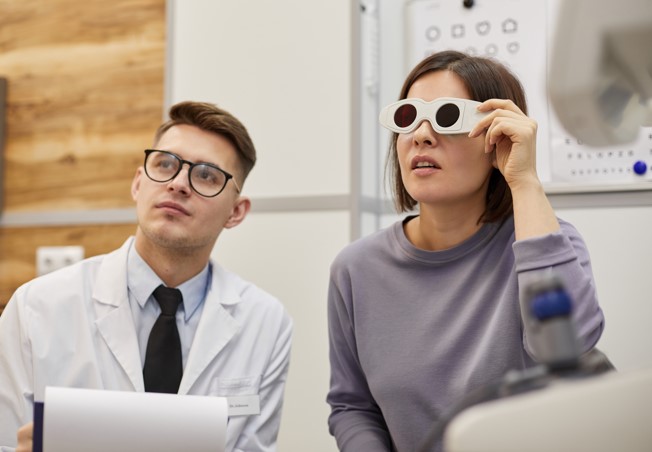Visionworks
Visionworks, once known as Eye Care Centers of America, Inc., is a leader in eye care services. It has more than 670 optical stores across 42 states and the District of Columbia.
Visionworks strives to provide excellent customer service, high-quality products, and services at the best price and selection.
Their stores carry designer and exclusive brand sunglasses, frames, accessories, and the latest technology in vision correction.
They also offer comprehensive services such as contact lens dispensing, in-store labs that provide one-hour service for many prescriptions at multiple locations, and doctors of optometry near or at every site.
Like any addiction, prolonged exposure to digital screens is known to cause detrimental health problems, which is why the American Optometric Association is stressing the importance of comprehensive eye care and attempting to ramp up awareness regarding the adverse effects of computer vision syndrome by observing the month of March as Save Your Vision Month.
According to the association, the syndrome, also known as digital eye strain, describes a group of vision-related problems that arise after prolonged computer, tablet, e-reader, and cellphone use.
Many individuals experience eye discomfort and vision difficulties when viewing digital screens for extended periods of time.
“A large research study done by the National Eye Institute found that nearsightedness among Americans has experienced a boost of more than 66 percent in the past 30 years,” said Robert Pretli, Visionworks of America director of professional services.
Pretli said this phenomenon is largely attributable to the increasing amount of time Americans spend with their eyes fixed on digital screens.
“In the short-term, these activities can cause headaches, fatigue, dry eyes, and blurred vision; however, if you do not challenge your eyes to focus on distance, nearsightedness might be a long-term effect of using too much time looking at the screen.”
In addition to the long and short-term symptoms of the syndrome, Pretli said the ailment could ultimately lead to vision loss.
According to a Visionworks study, 82 percent of Americans use a computer or mobile device on a day-to-day basis. According to the optometric association, the average American worker spends about seven hours per day on their computers.
To prevent the effects of the syndrome, the association recommends implementing what it calls the “20-20-20 rule,” a simple three-step process in which individuals should look 20 feet away from their screen for 20 straight seconds every 20 minutes throughout the day.
“The best way to negate the effects of CVS is to change your focus,” Pretli said.
“The 20-20-20 rule is a simple way to make sure you give your eyes a break — every 20 minutes, look 20 feet away for 20 seconds, periodically activating your distance vision and shifting your focus and minimize the symptoms of CVS.”
For people who may already be experiencing the effects of the syndrome, the association recommends individuals obtain regular eye care, as well as make changes to how they view screens.
In some cases, individuals who do not normally require eyeglasses may benefit from prescription glasses designed specifically for computer use.
“Preventative care is always the best care,” said Pretli. “Make sure to visit your optometrist for an annual comprehensive eye exam. Regular visits can help monitor your overall eye health.
However, if you start experiencing issues from prolonged screen exposure, you can talk to your optometrist about prescription computer glasses,
Visionworks also provides contact lenses online at visionworkscontacts.com.
Eye Doctors
It would be normal for eye doctors to be capable of diagnosing glaucoma and cataracts. But you may be surprised at the other types of diseases that an exam might reveal.
Dr. Inder Singhal, a Louisville-based retina surgeon, stated that there are many conditions eye doctors can spot. These include diabetes, high blood pressure, and brain tumors, as well as multiple sclerosis.
Singal said that he had seen bleeding in her eye and received a photo of the young girl about four weeks back. A pattern of bleeding can be compared to diabetes.
Bleeding spots or other signs of disease can often be detected during a dilated eyes exam. Typically, eye drops are used to open the pupils and allow for a better view inside the eye.
The visual field test is another check that can detect problems. It helps to determine if there are any issues with peripheral vision or side vision.
Singal stated that MS (multiple sclerosis) could cause optic nerve damage. This could be swelling or atrophy. Optic nerve damage is common in tumors. Visual field defects can occur in strokes. You might experience hemorrhages or uveitis in infectious diseases such as HIV, syphilis, or tuberculosis.
Importance of Early Eye Exam
The American Academy of Ophthalmology is advising that you have an eye exam with dilation at 40. If you have a history of eye illness or are at risk for it, the examination should be done sooner. It is vital to diagnose early signs of eye disease, get proper treatment, and make lifestyle changes that will help.
Singal stated that if you have vision problems such as blurred vision, floaters, or distortions, it’s a sign to visit the eye doctor.
He said, “If you are experiencing symptoms, don’t ignore them. Just seek help.” “If you don’t see well, it’s not because of aging. It’s not because you haven’t worked hard enough or are tired.
Mark Hinds, a Jeffersontown, Ky. resident, noticed an issue with his left eye as he was getting ready to work in September 2014. He felt like he was looking through a tube of cardboard.
Hinds claimed that he saw Singal and was told by him that it wasn’t an eye problem. A mini-stroke is something that you should discuss with your doctor and possibly a cardiologist.
Hinds said, “Within a month, I was having open-heart surgery to replace my defective aortic valve.” Hinds is glad that he quickly reported his symptoms. “I have always believed that your eyes are your soul’s window, but I didn’t think they would be your window to your health.
Hinds, now 59, was a patient of Singal and had a doctor-patient relationship because of eye surgery.
Optometrists such as Dr. Richard Gersh from Visionworks also see patients with undiagnosed health problems that need to be followed up. He said that many people with high blood pressure are not diagnosed and are referred to primary care providers.
James McKenzie (a patient of Singal) was in recovery from retinal surgery in 2010 when his wife noticed that McKenzie was having problems with his peripheral vision.
Shortly after, McKenzie was brought back by Singal for further testing. He quickly referred McKenzie for an MRI (magnetic radiation imaging), which revealed a brain tumor.
McKenzie, 65 years old, said that the tumor was actually on your optic nerve. This was affecting my peripheral vision on the left side.
McKenzie, who received 30 radiation treatments in Cincinnati, stated that the brain tumor was malignant and not operable, but it doesn’t seem to be growing.
Dr. Singal literally saved my life, or at the very least, has extended my life.
Darla Carter, the reporter, can be reached at 502-582-7068 or on Twitter @PrimeDarla.
SPREAD CHECKS OVER YOUR EYES
Ask your eye doctor when you should have an eye exam. The American Academy of Ophthalmology recommends that healthy individuals follow this schedule.
However, some patients may need to be seen more often due to certain conditions, risk factors, or other reasons. You should also report any vision problems such as blurred vision, floaters, or distortion.
Age 65 and older It could take up to 2 years.
Ages 55-64: Every 3 to 5 years.
Ages 40-54: Every 2 to 4 years.
You are younger than 40: 5-10 years.









